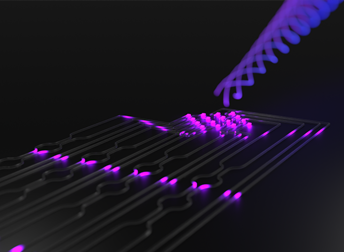Today, various degrees of freedom of light fields are used for the efficient and robust storage and transmission of information. The analysis of complex light fields, especially in the form of decomposition into a predefined basis, e.g., spatial light modes, is a central task in many applications. Established methods such as polarimetry, phase-front and intensity measurements are generally used for this purpose. The OpNaQ group has been breaking new ground in this area for some time now, developing and using compact, versatile, and highly precise solutions based on photonic integrated circuits.
The photonic platform [2] developed by the group in collaboration with international teams has already attracted attention for its versatility, e.g., for the generation [3] and detection [4] of light. Physicists from the OpNaQ group at the University of Graz have now used this integrated photonic processor for the first time to decompose complex light fields [5].
In the article published in Nature Communications [5], the research team presents very exciting results that were developed at the Christian Doppler Laboratory for Structured Matter Based Sensing [1]. At the heart of the work is the aforementioned photonic integrated system, which is used to decompose structured light into its spatial constituent modes and, thus, analyze it in detail. This enables a very precise investigation of highly complex fields, which could play a pivotal role in optical communications with such light fields in the future. The authors demonstrate that even with only 16 pixels on the photonic chip, experimental decomposition into up to 9 constituent modes is possible.
In particular, a comparison with existing methods, such as Shack-Hartmann sensors or spatial light modulators for dissecting the light field, shows the advantages of using integrated photonic processors for these applications. The implementation on the widely used silicon platform eases fabrication, while current research also focuses on scalability.
Contact:
Dorian Brandmüller und Peter Banzer; Optics of Nano and Quantum Materials (website)
[1] Christian Doppler Laboratoy for Structured Matter Based Sensing; https://structured-matter.com/
[2] https://cordis.europa.eu/project/id/829116
[3] Bütow, J. et al., Generating free-space structured light with programmable integrated photonics. Nature Photonics 18, 243–249 (2024).
[4] Bütow, J. et al., Spatially resolving amplitude and phase of light with a reconfigurable photonic integrated circuit. Optica 9, 939–946 (2022).
[5] Sharma, V. et al., Universal photonic processor for spatial mode decomposition. Nat Commun 16, 7982 (2025).
